Like so many Devonian climbing seeds, this one was sown by a certain Kendal Palmer, the shire-based superhero whose nose for pushing the envelope of South West climbing has been hyperactive for more decades than he, or myself for that matter, would care to remember.
Ken is a visionary, a man who deals in solutions rather than problems, untapped potential where others see insurmountable obstacles, or unjustifiable weirdness! For example, it was Ken who unlocked the mysteries of The Cauldron at Berry Head, solving the riddle of the impassable zawn by first finding and subsequently affixing a hefty piece of shipping rope to either side of the chasm, hence unlocking what is, for me, the absolute highlight of the country’s best route, Rainbow Bridge (and not just because of the name!). It was Ken who climbed the alluringly snappy Lord of the Prawns to give the South Hams shale something to really shout about both in terms of quality (***) and challenge (E7)…and all in such a beautiful location. Ken has single-handedly sorted out the Sanctuary Wall, replacing pegs and threads, whilst also adding new lines, to create the SW’s ultimate adventure sport(y) crag. He put up Devon’s first 8a DWS with the immaculate, and high enough thank you very much, Christine. He even has a few reasonably tricky first ascents at Anstey’s Cove next to his name. But pride of place in the ‘Ken Palmer as visionary’ greatest hits list must be Ginger Pom, Holcombe’s finest…well, OK, only route; as diminutive as its creator, this 12m long potatofest ends at the point the teetering three part ladder reached, the crumbling umber of the cliff’s sandstone matrix soaring a further 40m in an overhanging sea of ever more disheartening rubble. However, at its base, where the winter storms work their relentless magic on the Old Red, the rock is surprisingly solid, compact and clean…and with a generous helping of (circa 1990) homemade bolts showing the path, it’s a mystery as to why Ginger Pom isn’t regularly featured in one of those ‘best 7cs in the country’ threads that pop up every so often on your favourite climbing forum.

6c but not as you know it – the ridiculous Spud-U-Love at Potato Head. Steve Pack and Murray Dale do battle.
In so doing Ken pointed to the future of Devonian sports climbing, at least as far as I am concerned. Having more-or-less run out of untouched limestone and having eyed the series of seemingly tottering yet vividly hued and enticingly leaning cliffs that inhabit the stretch of coastline north of Torquay from the relative safety of the Babbacombe crags for many years, it took a walk with wife, kids and dog around the amazing towers at Watcombe, coupled with a thought process that ‘if the rock’s good enough for Ken…’ to convince me that this was a possibility worth exploring further. Unfortunately Watcombe Towers (Faulty Towers for some perhaps?) overhang relatively busy dog walking terrain so, even if the rock was of Taipan Wall quality, climbing there would probably not be a risk worth taking. But we headed on down to the beach and then I speculatively traversed north around the headland to a find a gargantuan yet horrendously sandy edifice that was obviously completely unjustifiable in terms of offering any climbing potential. Undaunted and ever optimistic I continued in my quest; just around the next headland the rock looked a little more promising and got me thinking that perhaps this wasn’t a such hopeless escapade after all. And that’s when I turned around and saw, on the other side of the bay, the intriguing limestone plating peaking out from behind the foreground at the top of what is now Fast’n Bulbous, one of Potato Head’s clutch of high quality 7cs. It looked as though there was a sliver of cliff, slight but intriguing and perhaps worthy of closer inspection…
Fast forward a couple of weeks and with the son in tow for a touch of ‘coastal adventuring’ with his old man (translation: out with father looking for new crags whilst forcibly being made to MOVE…AWAY…FROM…THE…XBOX) we boulder hopped along the southern edge of the beach, then clambered laboriously around the jumble of blocks, rock pools and conglomerate pinnacles (which, in climbing terms, looked promising in their own right) that form the complex headland to eventually stand underneath the 30m high, 75m wide, 20 degree overhanging crag that has since become known as Potato Head (aka Riglos-On-Sea). But then, somewhat inevitably, initial excitement turned to disappointment – such potential but just not climbable? Yet again I found myself thinking, ‘why do I live in the part of the country which must have the highest choss to climbable rock ratio in the world?’ Perhaps, it would be easier to bear if there were no cliffs at all but living where I do, pretty much every stroll along the coast path reveals another hectare of overhanging, unclimbable rubble. And, it appeared, here was another instance. However, lurking in the gulch at the base of the crag was something particularly exciting, a feature that even my downbeat state of mind could not tarnish. A perfect, meaty 12 metre long tufa system led enticingly out of the depths and was surrounded by fused limestone that had somehow encased the underlying sandstone conglomerate in what looked to be a quite convincing manner. If nothing else I could somehow equip the tufa and Devon would have it’s own little taste of Spain.
I enlisted local geologist and climbing guru Steve Pack, to give the crag the once over. Steve is a measured individual who keeps his ardent enthusiasm for the sport cloaked under waist deep layers of pragmatism so I was delighted when he pronounced the cliff was ‘well worth a go’, my initial pessimism rapidly dissipating with his words of encouragement. We decided to try to top rope a line on the severely overhanging right hand end of the crag because the base of the crag in this section is relatively friendly whilst also housing sandstone that seemed to be a bit more compact than the more heavily featured left and middle sections of the cliff. But with stuff to hit behind the belayer and a severely overhanging twenty metres of cliff above us scattered with ‘potatoes’, some the size of footballs, apparently willing gravity to do what it will, it was painfully obvious that this undertaking would require some careful planning and preparation if top roping it was going to offer an injury/death free experience. Eventually locating the top of the route (having abseiled through three or four incorrectly located and somewhat painfully hewn bramble tunnels first) and then peering down the line of the intended route, it became blatantly clear that a straightforward top rope would be perilous at best, suicidal at worst. A fall at the base of the climb would most likely result in the climber being swung twenty feet out from the crag; either careering through the dirt on rope stretch or, probably worse, through the air and into the rising slab of rock behind. However, in a moment of Great Egg Race like ingenuity (if you’re too young to recall it, look it up on YouTube), we stuck a low bolt into the (what turned out to be) reassuringly reliable sandstone and then dropped a second rope which we attached to the bolt. We then clipped back into this ‘guide line’ using a sling. The sling would run up the guide rope as we climbed and would arrest our swing should we fall off. A gri-gri supplied the tension in the guide rope and we were good to go. Top roping has never been more terrifying or awkward but the climbing itself was…actually really quite good, the rock much better than appearances suggested and the potatoes were, on the whole, well baked in place.
This line eventually became Mr Potato Bottom, a technical little 7a which ends at a mid height lower off; the good rest afforded by the slight easing of angle and reasonable holds being a natural place to draw part I to a close. Above, the cliff reared up – a rounded break with a huge sculpted block was tantalisingly out of reach and above this more heavily cobbled yet increasingly leaning territory offered a sniff of a possibility, ultimately heading to what appeared to be a final handball size clipping jug. Top roping this was nigh on impossible as, even with the guide rope in place, a fall left us hanging in space with no way of regaining the rock so Steve and I had to gradually bolt our way down the line of the extension, there being no opportunities available to get any natural protection and the cliff being far too overhanging to glue in more than one bolt at a time. Each bolt added meant a new section could be worked with a bit more ease than before until eventually all the bolts were in place and we were able to try the route from the ground up. Gradually the upper section of the route revealed itself; a fantastic set of varied and sometimes dynamic moves up ever steepening territory built to a final big move to the aforementioned handball. We were over the moon at both the quality and difficulty of the climbing, the moves and positions were excellent and the route’s grade resided somewhere in the high 7s, so perfect for us to have something to sink our teeth into whilst still having an outside chance of success. In the end Steve prevailed, dispatching with aplomb and Potato Head had its first full length route with the eponymously named Mr Potato Head. We graded it 7c+ but (relatively) popular opinion has meant it has settled down to a punchy, challenging 7c. Whatever, it’s a great climb and one that can be climbed in any weather, once any seepage has tried off in the Spring!
And from these beginnings we never really looked back. We have now started to develop two other conglomerate cliffs in the vicinity (all three are detailed below) and I was shocked to realise just the other day that I was climbing my first routes on limestone in over a year…a situation that I would have thought preposterous a few years ago. The three cliffs in question are very different in character; the rock, climbing style, outlooks and access vary considerably but they all have one unmistakable feature in common…these are not conventional sport climbing crags and they reward an open minded, adventurous spirit, despite the fact you are clipping bolts!
Potato Head
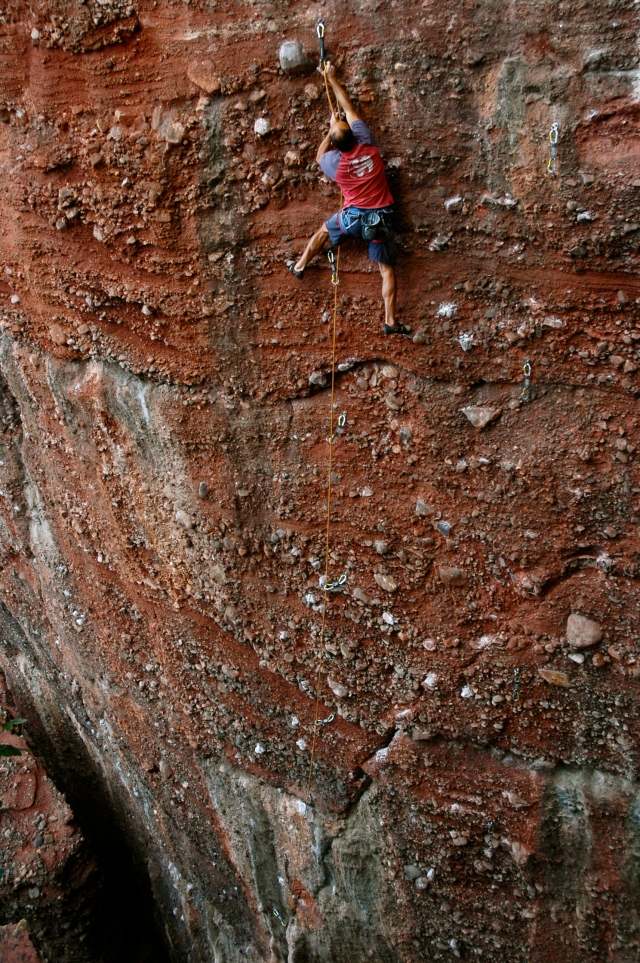
25m in and still the headwall to tackle. Macca embroiled in the upper reaches of The Maris Piper (8a) – Potato Head
The first of the three crags to be developed, Potato Head, faces north east and is in the shade from about 8am in mid summer. On hot days when shade is sought there is nowhere better in South Devon. What’s more the crag is Devon’s prime ‘umbrella crag’ so if you’re caught out in an inclement spell and your project at Anstey’s, Torbryan or Churston is out of action, try here before heading home. Potato Head has relatively easy access from the beach at Watcombe, although the boulder hopping can become a bit tricky on super high spring tides.
Once the base of the crag is reached you are well above the tide line (none of these crags are tidal at their base) and your only worry is disappearing absentmindedly down one of the multiple crevasses at the foot of the left hand part of the cliff. The number of quickdraws, belay plates, screw gates etc that have somehow slipped out of grasp to clatter down a cleft and finally plop into briny depths below is remarkable; why you are 10x more likely to drop something when you really shouldn’t than when it doesn’t matter at all is anybody’s guess, but that seems to be the first rule of Potato Head Club! On one occasion a mate of mine dropped his fleece down one of the gulches where it lodged just above the sea. He managed to burrow down to eventually retrieve it and then ten minutes later somehow did the same thing all over again!
Don’t worry if this all sounds a bit too much for you though, the right hand section of the cliff has a flat earthy base from which two of the more amenable ‘first pitches’ start – Mr Potato Bottom (7a) and Cheeky Little Blighter (7a+). Lord of the Fries (Oven Ready), a superbly pumpy 7c can also be accessed without descending into the depths although the options for the belayer are either to take a hanging belay on the suspended slab wedged at the landward end of the main chasm…or descend into its murky depths and belay as you would for the lower, ‘Deep Fat’, versio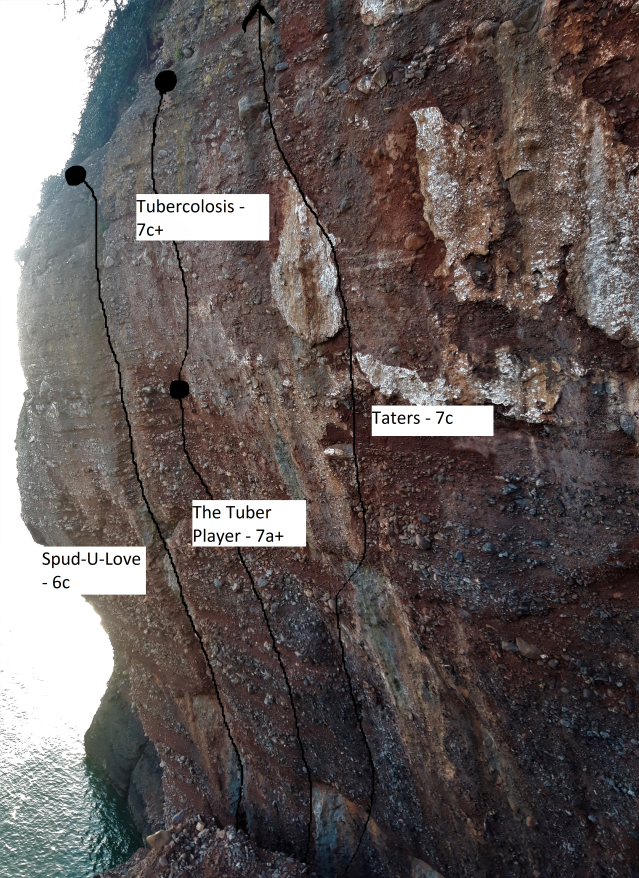 n of this route (still a project at the time of writing).
n of this route (still a project at the time of writing).
The far left of the crag has three routes that start off the massive free standing block that appears poised to slither off into the English Channel at some point in the not too distant (geologically speaking) future.
When this goes, these routes will become:
a) Considerably longer.
b) Considerably harder.
c) Considerably easier to access.
But I wouldn’t hold your breath as I am sure it’s not going anywhere for a while! In the meantime, ‘the bad step’ has to be negotiated. Once you have acclimatised to the surroundings this isn’t too bad at all, but on a first visit the step could form the crux of the whole day…especially on the return journey! Top tip for the very nervous, upon completing your climb you could continue back to reverse the step whilst still being on the end of the rope!
So what of the climbing? Well Potato Head is the hardest of the three crags being steeper and more sustained in nature, but to compensate, the potatoes here are more plentiful and proud than on the two other crags. Most of the routes are pumpfests that, for me, are far more draining than the classic Anstey’s enduro route, Empire of the Sun. The central section of the crag houses five routes that are all in the mid to high 7s, all comparable to Empire in terms of quality…and all a bit or considerably harder (if you ask me). In order from left to right they are: Taters (7c), Fast’n Bulbous (7c), King Edward’s Wall (7c+), The Maris Piper (8a) and Lord of the Fries (7c). Pride of place has to go to The Maris Piper, the route that tackles the main tufa system before blasting up and R into a seemingly endless and increasingly leaning cobbled highway culminating in a potentially heartbreaking final headwall. Fast’n Bulbous has also proven 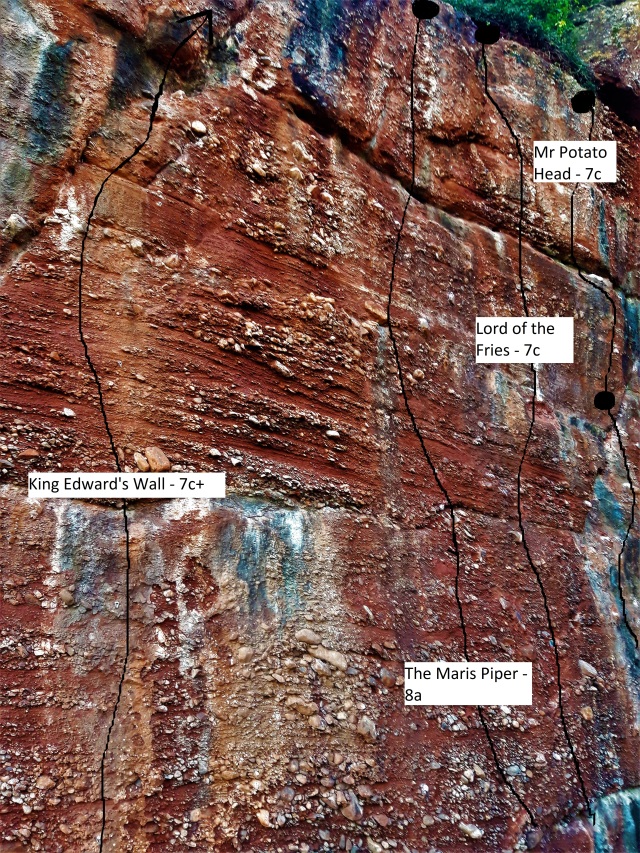 popular and for the past few seasons has had a permanent line of chalk to follow through the summer months. A bit like Empire on steroids, this route has a habit of spitting off would be suitors on its very last hard move; getting established on the weird flowstone pillar at 20m. All five routes are spectacular challenges, the three on the right offering up routes that get on for 30m in length on territory that is continuously overhanging throughout.
popular and for the past few seasons has had a permanent line of chalk to follow through the summer months. A bit like Empire on steroids, this route has a habit of spitting off would be suitors on its very last hard move; getting established on the weird flowstone pillar at 20m. All five routes are spectacular challenges, the three on the right offering up routes that get on for 30m in length on territory that is continuously overhanging throughout.
On the left and right flanks of the crag, routes are a bit different tending to have easier lower sections that lead to mid height lower offs beyond which upper reaches that tend to test power endurance rather than stamina reserves can be enjoyed by those wanting a sterner challenge. On the far left, the crag ‘warm up’ of Spud-U-Love (6c…but not as you know it) offers a severely overhanging crack climbing ‘experience’ that has divided opinion like a  vat of marmite. I love it! Next to this is the pumpy Tuber Player (7a+) which extends into Tubercolosis (7c+) via a long throw to a good flake, then straight into a (for me) debilitating and extended boulder problem on slopey cobbles. At the far right end of the crag the Mr Potato Bottom/Head combo offers a similar experience although the good rest at the mid height lower off on this route makes the upper section slightly less taxing than on Tubercolosis. Right again is Cheeky Little Blighter/The Blight the upper section of which gives the crag its hardest climb to date and offers up a relentless set of hard, dynamic moves through extremely steep ground from a less than ideal ‘rest’ at the lower off of Cheeky Little Blighter. Spare a thought for first ascensionist Ged Desforges who chose this route on which to cut his bolting teeth…on what is probably one of the most challenging pieces of rock to bolt in Devon; equipping this route must have been a painstaking and time consuming business that would likely to have been almost as taxing as the redpoint ascent itself!
vat of marmite. I love it! Next to this is the pumpy Tuber Player (7a+) which extends into Tubercolosis (7c+) via a long throw to a good flake, then straight into a (for me) debilitating and extended boulder problem on slopey cobbles. At the far right end of the crag the Mr Potato Bottom/Head combo offers a similar experience although the good rest at the mid height lower off on this route makes the upper section slightly less taxing than on Tubercolosis. Right again is Cheeky Little Blighter/The Blight the upper section of which gives the crag its hardest climb to date and offers up a relentless set of hard, dynamic moves through extremely steep ground from a less than ideal ‘rest’ at the lower off of Cheeky Little Blighter. Spare a thought for first ascensionist Ged Desforges who chose this route on which to cut his bolting teeth…on what is probably one of the most challenging pieces of rock to bolt in Devon; equipping this route must have been a painstaking and time consuming business that would likely to have been almost as taxing as the redpoint ascent itself!
The Nudey Cliff
About a mile south of Potato Head, at the point where Torquay Golf Course jarringly abuts the coast path, the large hanging valley that houses what has become known as The Nudey Cliff leads off down to the sea…and Torbay’s premier nudey beach. Depending on your bent, The Nudey Cliff either fortunately or disappointingly resides some way above the water so that sunbathers and climbers can coexist in blissful (or disappointed?) ignorance of each other.
In contrast to Potato Head, The Nudey Cliff is a mid grade climber’s dream and the clutch of 7a to 7b routes here actually make this more like the rogue, wayward sibling of Torbryan Quarry than that other potato based edifice on the Northern edge of the ‘Conglom Coast’. Whilst the flowstone flutings at Torbryan are hard to beat, the grandeur of the routes on the Main Wall at the Nudey Cliff make these routes more than a match, especially if you’re looking for a long, sustained and memorable trip. Additionally, the smaller buttress of rock on the left of the cliff (Bashful Buttress) offer a number of easier routes in the 6s, all of which climb better than they look (admittedly, they do look pretty awful). These can be pretty dusty if they have been left unclimbed/uncleaned for a while but a quick brush and they are good to go. To add to the contrast with its big brother, the rock at The Nudey Cliff is much less featured than at Potato Head; potatoes tend to be set deeper in the matrix and are smaller and less obvious. The sandstone appears less stoney, perhaps even muddy(?!) on first acquaintance. If you are looking to push your onsight grade here, I would recommend you choose a route that is well chalked up…as one out-of-season visitor commented, “onsighting a 7a here required as much, if not more, effort than a 7c onsight in Chulilla”. The searing red of the rock here is often accentuated by the searing heat; a south facing suntrap (shade does, however, present itself on the east facing side wall of Bashful Buttress and in the thick foliage at the base of the cliff), this is a wonderfully relaxed place to climb on temperate or even cold but bright days. The cliff can withstand light rain as long as the wind is not from the south and, crucially, it doesn’t seep at all so the routes stay in condition throughout the winter, when the main wall holds on to whatever sun there is until about 3pm.
Although far easier to bolt than Potato Head due to its less overhanging nature, working my way to the top of the cliff prior to the first exploratory abseil took a whole afternoon, two severely blistered hands and a body punctured by bramble thorns from head to toe.

Equipped only with a pruning saw and a pair of secateurs it soon became apparent that I was woefully under resourced and it was only through the creation of a sizeable ‘bashing stick’ that I was able to burrow/thrash my through the head high wall of prickles that stood between me and my goal…wherever that turned out to be (and it turned out to be in about the right place)! In the end the ‘bramble run’ is probably only about 200m long but it felt a lot longer than that in its creation. I’m not sure I have ever had so much fun!
 Climbing at The Nudey Cliff began with the varied and tricky to grade Do Ya Think I’m 6c? (6c…or is it??). The name had first been posited about 30 years ago by my dearly departed (and defiantly non-climbing) kid brother and I had had it in my back pocket ever since, waiting for the right opportunity to use it. Having top-roped the line a few times, and despite my top-roping pal Bruce Kirby suggesting that it was more like 7a, I was convinced it was a more-or-less benchmark 6b+. So…a (possibly slightly undergraded) 6b+ on a cliff of the nudey variety seemed like the perfect route on which to use Ben’s inspired route name! Subsequent ascensionists managed to convince me that it was nowhere near 6b+ so I have reluctantly upped the grade to 6c, which doesn’t work quite so well as a name but is perhaps more reflective of the grade of the route. Guidebook author extraordinaire, Pete Saunders, has suggested that as an onsight it is indeed a ‘7a nightmare’ but concedes that ‘with practice it morphs into an enjoyable 6c’. Hence, he suggests a grade of 6c+!? Whatever the grade, the route offers a smorgasbord of interesting climbing – hard and pumpy arete climbing to kick things off leads to a hands off ledge, step left onto an overhanging wall, then climb the crack feature to a long move on undercuts, into potato jugs then crimps, weight onto feet…at last…and on into tricky slab section and then the pushy finish though a small roof and into a couple of vague pockets to clip the lower off at 25m!
Climbing at The Nudey Cliff began with the varied and tricky to grade Do Ya Think I’m 6c? (6c…or is it??). The name had first been posited about 30 years ago by my dearly departed (and defiantly non-climbing) kid brother and I had had it in my back pocket ever since, waiting for the right opportunity to use it. Having top-roped the line a few times, and despite my top-roping pal Bruce Kirby suggesting that it was more like 7a, I was convinced it was a more-or-less benchmark 6b+. So…a (possibly slightly undergraded) 6b+ on a cliff of the nudey variety seemed like the perfect route on which to use Ben’s inspired route name! Subsequent ascensionists managed to convince me that it was nowhere near 6b+ so I have reluctantly upped the grade to 6c, which doesn’t work quite so well as a name but is perhaps more reflective of the grade of the route. Guidebook author extraordinaire, Pete Saunders, has suggested that as an onsight it is indeed a ‘7a nightmare’ but concedes that ‘with practice it morphs into an enjoyable 6c’. Hence, he suggests a grade of 6c+!? Whatever the grade, the route offers a smorgasbord of interesting climbing – hard and pumpy arete climbing to kick things off leads to a hands off ledge, step left onto an overhanging wall, then climb the crack feature to a long move on undercuts, into potato jugs then crimps, weight onto feet…at last…and on into tricky slab section and then the pushy finish though a small roof and into a couple of vague pockets to clip the lower off at 25m!
 As is so often the case, once the first route had been climbed, the floodgates opened. After all, if you’re keen to share/inflict your new offering with others you can hardly persuade them to come to a crag with only one route! So Steve and I set to work, myself abbing, cleaning and bolting, Steve always on hand as a top rope buddy, ‘beta and bolt positions’ expert and generally enthusiastic good egg. Before long the Main Wall had five glorious offerings, the aforementioned Do Ya…were joined by a quartet of low to mid 7s of the gently overhanging, sustained difficulties variety, especially on the central plum lines of Tan Solo and The Eyeful Toweller. The current last addition to the Main Wall had to wait a year; Chewbadger was named after a particularly feisty mammal that had a disagreement with a rival at the top of the crag, fell its entire length and somehow lived to tell the tale, a little dazed and confused but with no discernible long term damage, at least as far as we could tell. We were climbing at the time but luckily not on Bashful Buttress as that was on the flight path – the sight of a kamikaze badger whizzing past whilst being half way up Nudey Wonderland would not be good for the nerves! First climbed on the day of ‘the incident’, ‘Chewbadger’ the route takes the frankly outrageous central scoop to its capping roof and then an exacting wall via a good rest on a perched and only just big enough ledge to finish at just over 30m from the floor. Watch the end of the rope when lowering down!
As is so often the case, once the first route had been climbed, the floodgates opened. After all, if you’re keen to share/inflict your new offering with others you can hardly persuade them to come to a crag with only one route! So Steve and I set to work, myself abbing, cleaning and bolting, Steve always on hand as a top rope buddy, ‘beta and bolt positions’ expert and generally enthusiastic good egg. Before long the Main Wall had five glorious offerings, the aforementioned Do Ya…were joined by a quartet of low to mid 7s of the gently overhanging, sustained difficulties variety, especially on the central plum lines of Tan Solo and The Eyeful Toweller. The current last addition to the Main Wall had to wait a year; Chewbadger was named after a particularly feisty mammal that had a disagreement with a rival at the top of the crag, fell its entire length and somehow lived to tell the tale, a little dazed and confused but with no discernible long term damage, at least as far as we could tell. We were climbing at the time but luckily not on Bashful Buttress as that was on the flight path – the sight of a kamikaze badger whizzing past whilst being half way up Nudey Wonderland would not be good for the nerves! First climbed on the day of ‘the incident’, ‘Chewbadger’ the route takes the frankly outrageous central scoop to its capping roof and then an exacting wall via a good rest on a perched and only just big enough ledge to finish at just over 30m from the floor. Watch the end of the rope when lowering down!
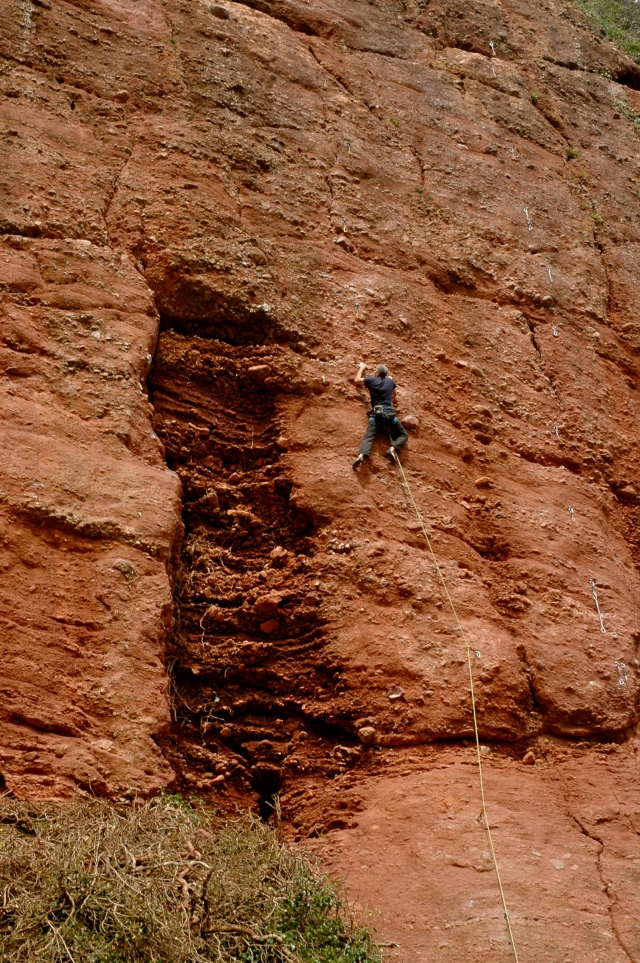
Not nudey at all! A fully clothed Brian Hannon styling his way up the all time classic The Eyeful Toweller (7a+) – The Nudey Cliff
Bashful Buttress is the Main Wall’s shy left hand neighbour and offers up some useful easier lines as well as a few short but sweet technical dainties, the one exception being the more substantial rising diagonal line of The Nudey Blues. This makes the most of the side wall and contains a great deal of variety in its 20m length. As previously mentioned, these pitches offer welcome relief on hot summer days whilst you are waiting for the Main Wall to lose the sun, but many are fine little routes in their own right and Nudey Wonderland, A Massage To You Nudey and Blame It On The Nudey (as well as The Nudey Blues) would all be super popular pitches were they to be transported a mile or two south!
Land Of The Giants
Although the Nudey Cliff’s longest routes just about make it to 30m in length, the four longest pitches all negotiate the Nudey Slab in their bottom 8m, hence diluting the effect a little. A few routes at Potato Head are in the region of 28m but the combination of chasm and complex topology means it doesn’t feel like a monolithic giant in the way that Land Of The Giants certainly does. The pitches here are monsters; continually overhanging, the seven lines bolted thus far leave very little change out of a 60m rope and 50 year old forearms! Probably my favourite of the three venues, I love Land of the Giants’ open aspect, the sun-filled mornings and cool afternoons, the vibrant tones and the flowstone extrusions. But most of all I love the climbing here – whilst Torbryan may look like South Devon’s version of the Costa Blanca, Land Of The Giants actually climbs like one of your favourite Spanish crags with nothing easy, nothing particularly hard, sapping of energy yet nourishing of spirit; these are routes to be cherished (when in condition). Imagine a cobbled version of the Oasis Sector at Chulilla and you won’t be that far off…apart from the tourist boats, gulls, potatoes; and access complications! Alright, rubbish comparison but the routes are long and pumpy, get my drift?
So let’s start off with the access and get the tricky bit out of the way first! Getting into the crag is relatively straightforward – find what possibly might be the right tree and commit yourself to a launch into the unknown, a 45m abseil, the bulk of which will be in space should find you on the accommodatingly flat earthy base that runs along the right hand end of the crag. Simples! Extricating yourself from the crag at the end of your session is another matter and, looking back, we were incredibly lucky that we were able to fight our way out on our first foray whilst avoiding a swim or a lengthy prussik up the ab rope.
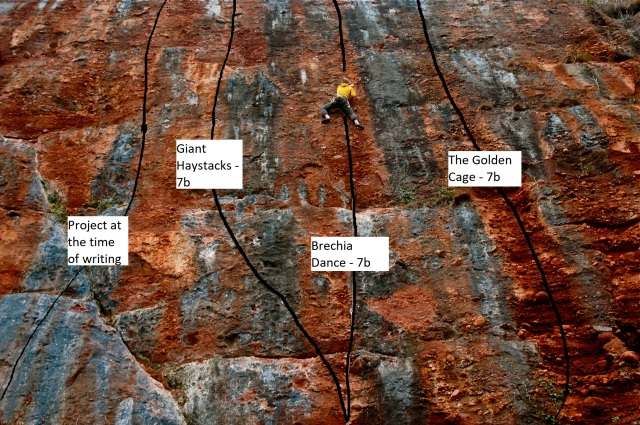 I had actually first found the crag on another ‘coasteering adventure’ with my poor, beleaguered son, Kit (he loves it really…). So I knew that about 150m north of the crag, via some boulder hopping and a little (tidal!!!) sea level traversing was a large cone of grass/brambles/shrubs/rubble. Unfortunately this did not reach the top of the cliff line, a 15m edifice extended beyond the summit of the cone. So a straightforward, yet tiring, walk out would not be possible. At sea level, beyond the cone lay the impressive and impassable Watcombe Cave (well…impassable unless you’re going to have a swim!). It felt as though the cliff would be just too much hassle to equip, my mindset at this time vacillating between ‘what’s the point in developing a cliff that nobody will come to?’ to ‘the routes here could be absolutely amazing, this is the crag you’ve been looking for all these years’. Of course, in the end my positive angel overcame my negative demon and one torrential June day Steve and I found ourselves, once again, bashing through head high brambles looking for the top of the cliff that led up from the summit of the ‘exit cone’. And, as luck would have it, when we eventually found the spot (one busted machete later), a slender yet sturdy enough tree was perched right where you’d want it and we were able to drop a length of rope down the 15m cliff so at least we had a means of escape…provided we could get to the end of the rope in one piece!
I had actually first found the crag on another ‘coasteering adventure’ with my poor, beleaguered son, Kit (he loves it really…). So I knew that about 150m north of the crag, via some boulder hopping and a little (tidal!!!) sea level traversing was a large cone of grass/brambles/shrubs/rubble. Unfortunately this did not reach the top of the cliff line, a 15m edifice extended beyond the summit of the cone. So a straightforward, yet tiring, walk out would not be possible. At sea level, beyond the cone lay the impressive and impassable Watcombe Cave (well…impassable unless you’re going to have a swim!). It felt as though the cliff would be just too much hassle to equip, my mindset at this time vacillating between ‘what’s the point in developing a cliff that nobody will come to?’ to ‘the routes here could be absolutely amazing, this is the crag you’ve been looking for all these years’. Of course, in the end my positive angel overcame my negative demon and one torrential June day Steve and I found ourselves, once again, bashing through head high brambles looking for the top of the cliff that led up from the summit of the ‘exit cone’. And, as luck would have it, when we eventually found the spot (one busted machete later), a slender yet sturdy enough tree was perched right where you’d want it and we were able to drop a length of rope down the 15m cliff so at least we had a means of escape…provided we could get to the end of the rope in one piece!
Excitedly, we headed along the coast path to where we thought the cliff was, only to be twice thwarted by that increasingly common affliction: premature bush whacking. Third time lucky we set up a wildly optimistic top rope on the line that would eventually become Brechia Dance and once more launched up into a sea of uncertainty, potatoes perched on rubble ready to drop, ledges covered in earth and ivy, brittle flowstone edges with the consistency and reliability of Ryvita. I swear those exploratory top ropes were far more terrifying than pushing it out on lead on the clean and relatively solid line that was to come (even with Murray Dale’s ‘sporting’ bolt positions!).
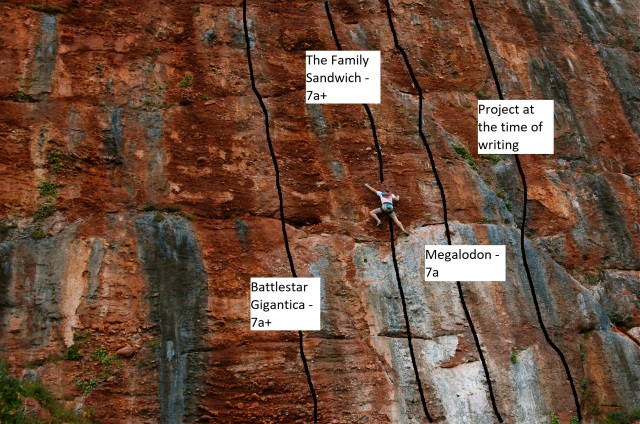 Although Brechia Dance is a fine line, it took a while before this route got equipped and led, my eyes and mind instead drawn to the unique 10m long ‘entry chute’ on what was to become Megalodon, perhaps the best place to start your relationship with LOTG. At 7a (on high gravity days it’s 7a+ though…) this route is the friendliest offering here being more featured and less pushy than the other routes. I have been climbing regularly since the late 80s and in all that time I have never come across a feature quite like that entry chute – an almost perfect semi cylinder, about 50cm in diameter, full of moulded, fused cobbles it climbs like a mildly pumpy dream working you nicely in preparation for the remaining 20m of cobbled and flowstoned delight. On first acquaintance these pitches seem to go on forever; as the cliff becomes more familiar…well, they still seem to go on forever, but it’s a forever you savour rather than endure!
Although Brechia Dance is a fine line, it took a while before this route got equipped and led, my eyes and mind instead drawn to the unique 10m long ‘entry chute’ on what was to become Megalodon, perhaps the best place to start your relationship with LOTG. At 7a (on high gravity days it’s 7a+ though…) this route is the friendliest offering here being more featured and less pushy than the other routes. I have been climbing regularly since the late 80s and in all that time I have never come across a feature quite like that entry chute – an almost perfect semi cylinder, about 50cm in diameter, full of moulded, fused cobbles it climbs like a mildly pumpy dream working you nicely in preparation for the remaining 20m of cobbled and flowstoned delight. On first acquaintance these pitches seem to go on forever; as the cliff becomes more familiar…well, they still seem to go on forever, but it’s a forever you savour rather than endure!
Megalodon has been described by one early visitor (who was experiencing the crag in an immaculate state having just been cleaned and bolted) as possibly the best 7a/+ in the country(!) but for my money it’s not even the best route here! In my opinion, Giant Haystacks earns that accolade with its wonderful flowing crux leading up a 10m sheet of flowstone past tufa holds, crimps and side pulls. It’s one of those sequences where it’s best to switch off your mind and let your feet do what they want to do…as that will be the way! Another favourite of mine, Battlestar Gigantica feels like the most immense pitch of all and the headwall, featuring two of the biggest potatoes (read: ‘beach balls’) on the Conglom Coast. Don’t worry (ha!), they have been lustily tested and are well embedded.
Seven lines in (six climbed and one still a project), we have only scratched the surface of the potential of this huge edifice. And whilst it’s an adventure cliff in every way but one, it’s well worth the effort, especially if the routes have been recently cleaned and the surface scrittle removed. If you fancy an outing do get in touch via the comments section of the blog – with such complex access it’s better that way! But maybe go and try out one of the other crags first…if you don’t like them, it’s unlikely that LOTG will be the crag for you!
Bolting
I thought it might be reassuring for the reader if I were to describe the bolts that have been used to equip these crags. Again taking inspiration from Ken Palmer, 10mm stainless steel or marine grade steel ReBar has been used, the main reason being that I am therefore able to create much longer bolts than are commonly available to purchase ‘off the shelf’. In fact the bolts placed have all been 200mm long, apart from a few extra long (I think 150mm) twisty bolts that were used as back up bolts on a couple of belays at Potato Head. Bolts have been glued in with epoxy resin and high quality Fixe or Petzl stainless steel plx hangars added.

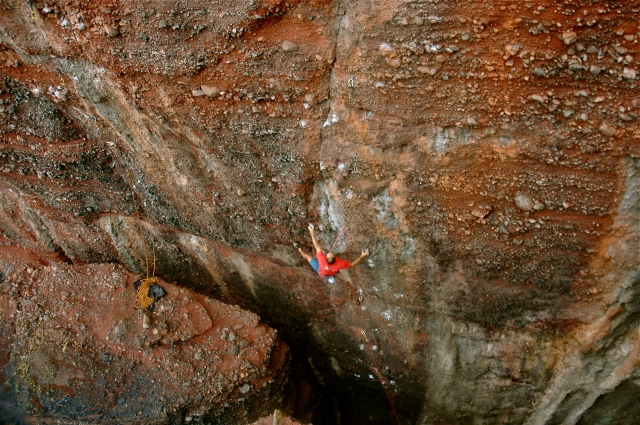







Hi Tom, any chance of any info on the LOTG access if you get a chance please?